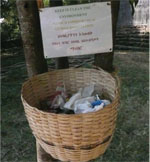Onsite handling, storage and processing

Onsite means these functions are concerned with solid waste at the place where the waste is generated. For residential waste this means at home in the household. Onsite handling is the very first step in waste management. It involves individual family members, households and communities, all of whom need to know how to handle waste properly at this level. ‘Handling' means the separation of wastes into their different types so they can be dealt with in the most appropriate way, for example, separating putrescible waste for composting. The benefits of appropriate onsite handling include reducing the volume of waste for final disposal and recovering usable materials.
Onsite storage means the temporary collection of waste at the household level. It is important that waste is stored in proper containers. These could be baskets, preferably made from locally available materials, plastic buckets or metal containers. Larger containers or dustbins, especially those used for food waste, should be leakproof, have tight lids and be long-lasting. The size of the container should be sufficient to hold at least the amount of solid waste that is generated per day at household level. Institutions and businesses should consider having onsite storage facilities with greater capacity. The proper location of storage containers and the frequency and time of emptying are important factors to be considered for efficient onsite storage.
Some wastes will need some sort of onsite processing before the next steps, for example, in areas where false banana (enset) is used as a staple crop, the byproducts should be chopped into pieces before composting to speed up the rate of decomposition.